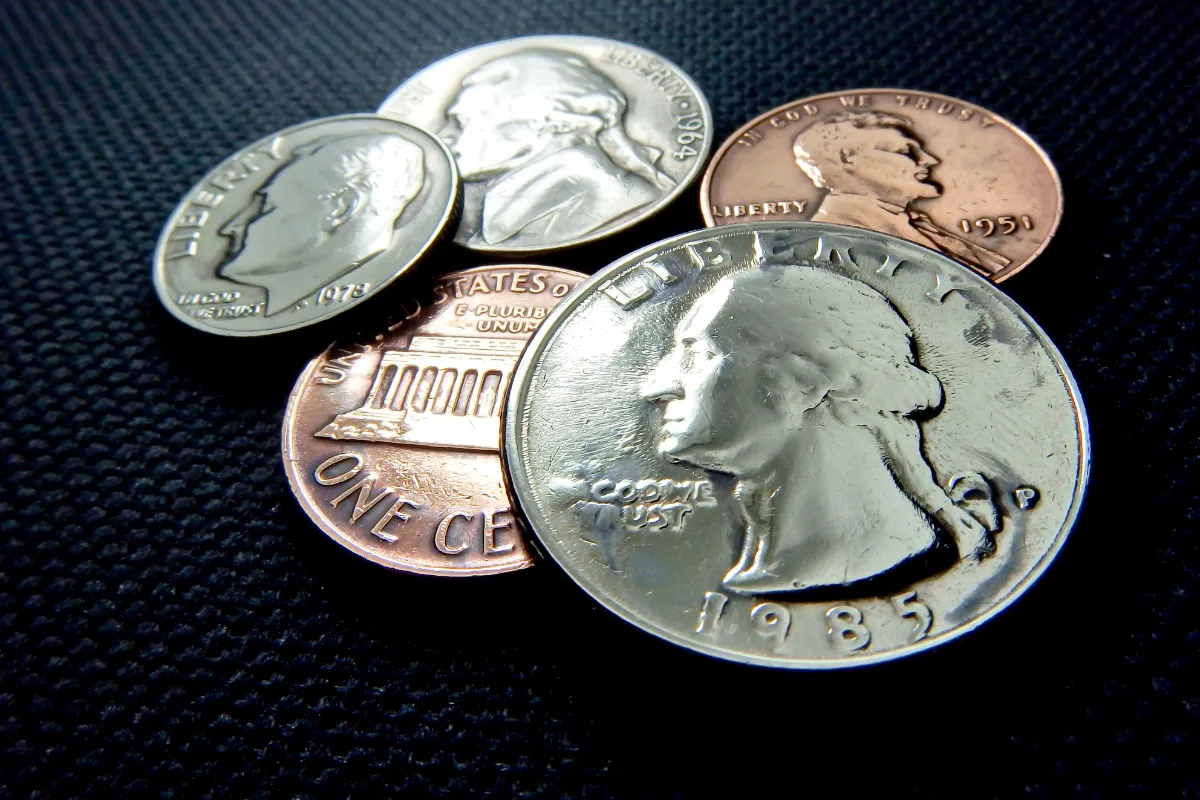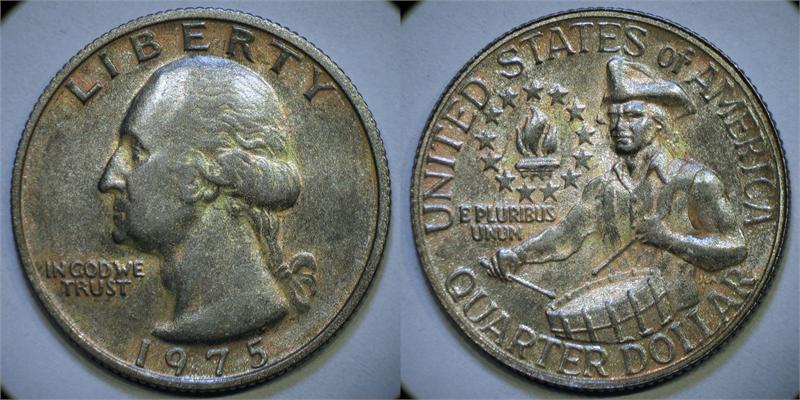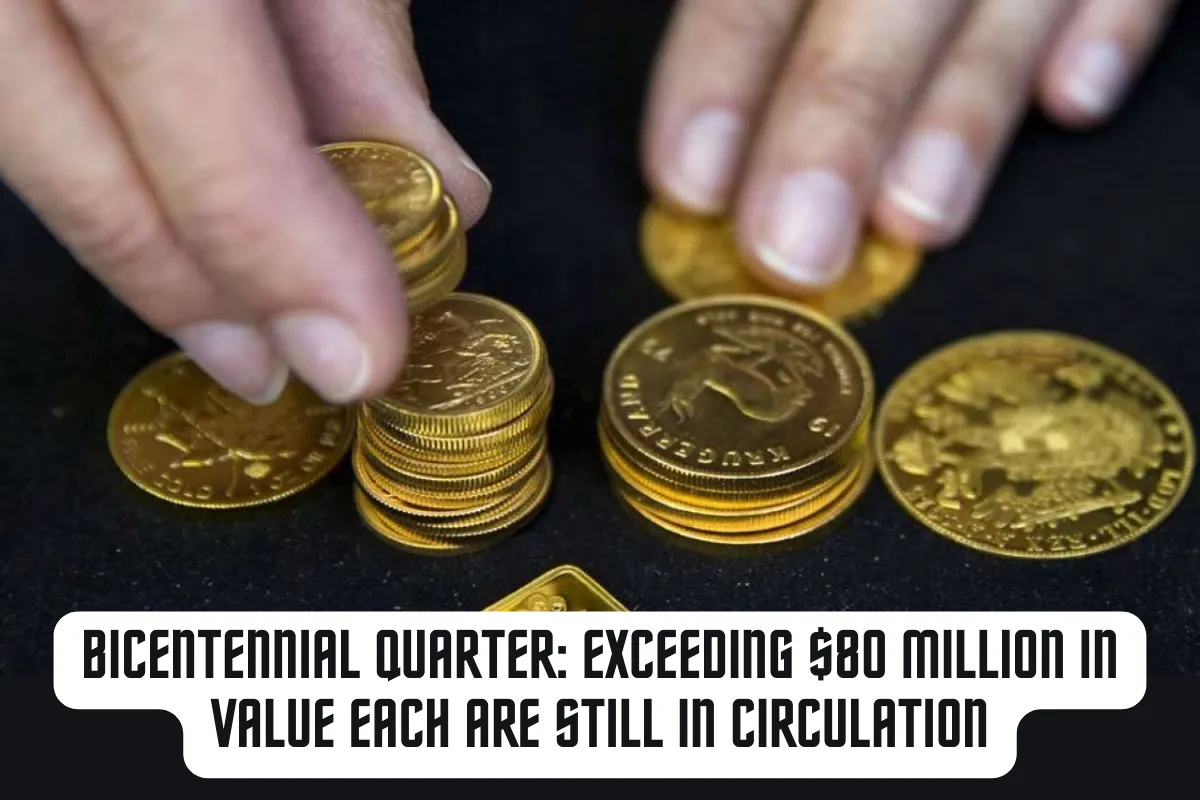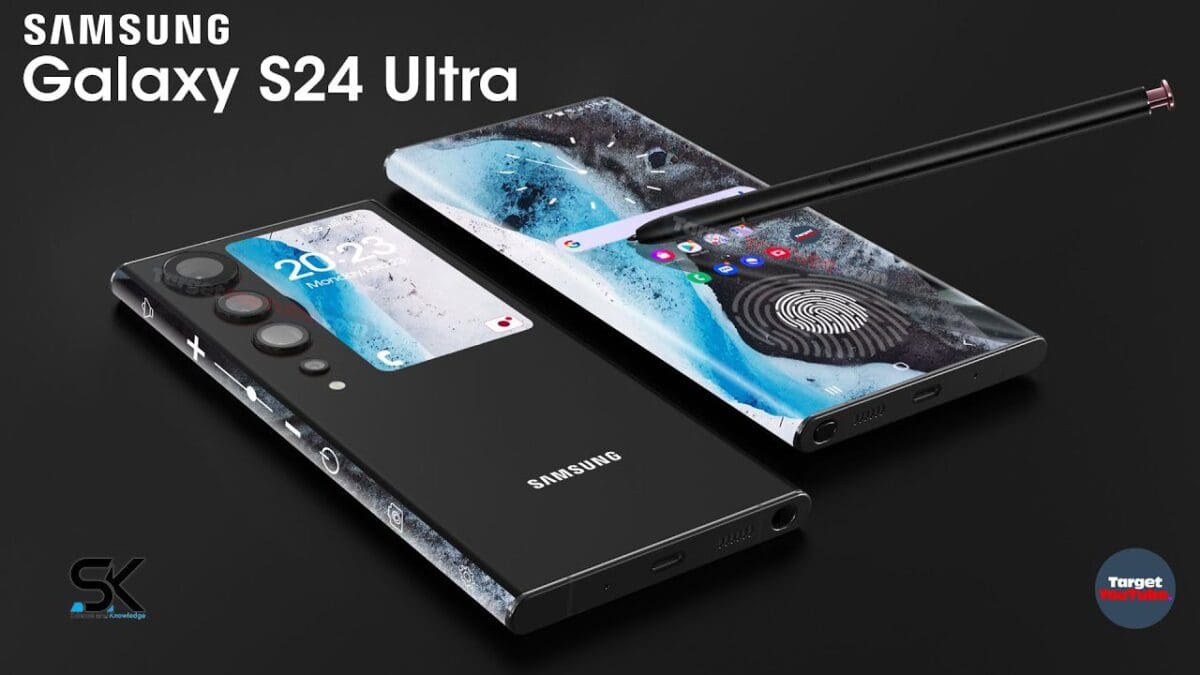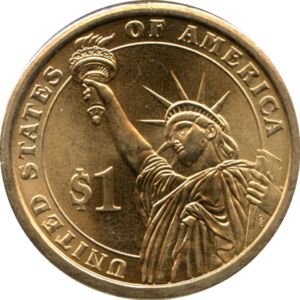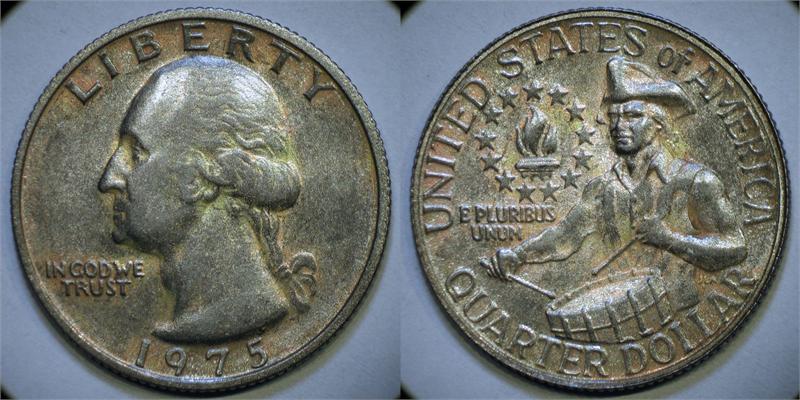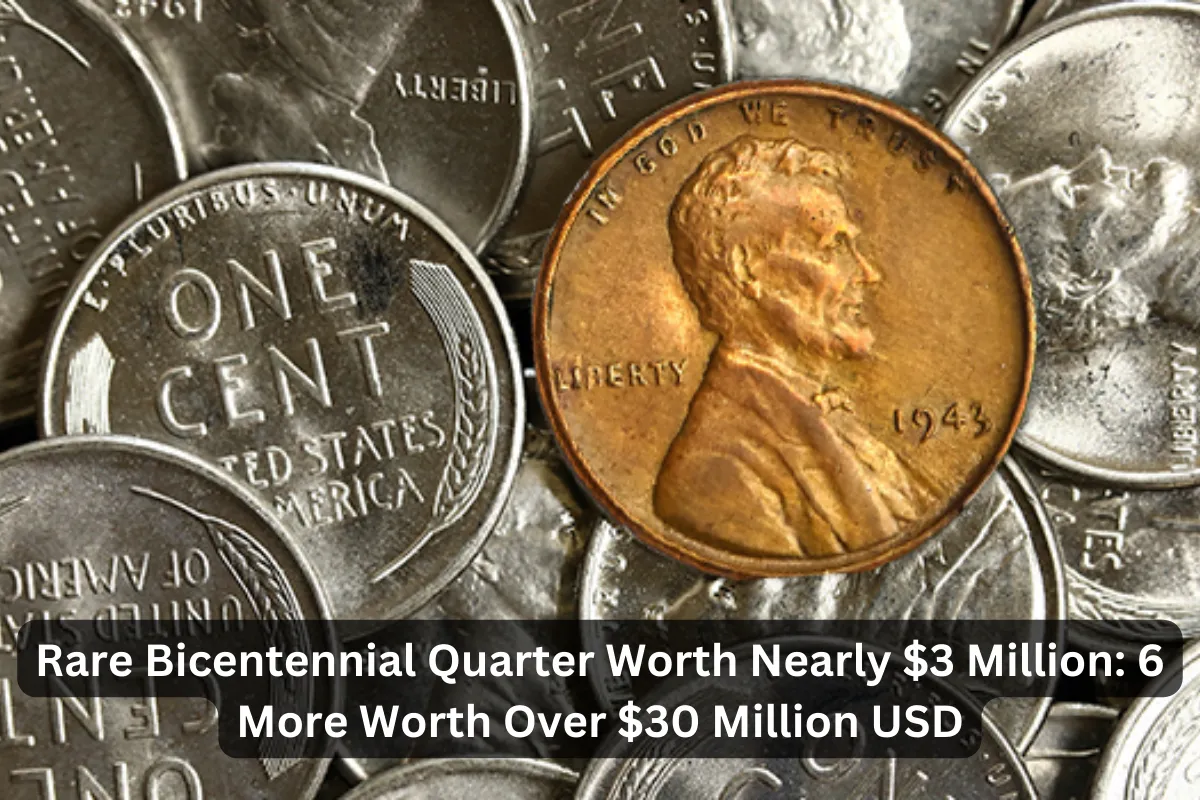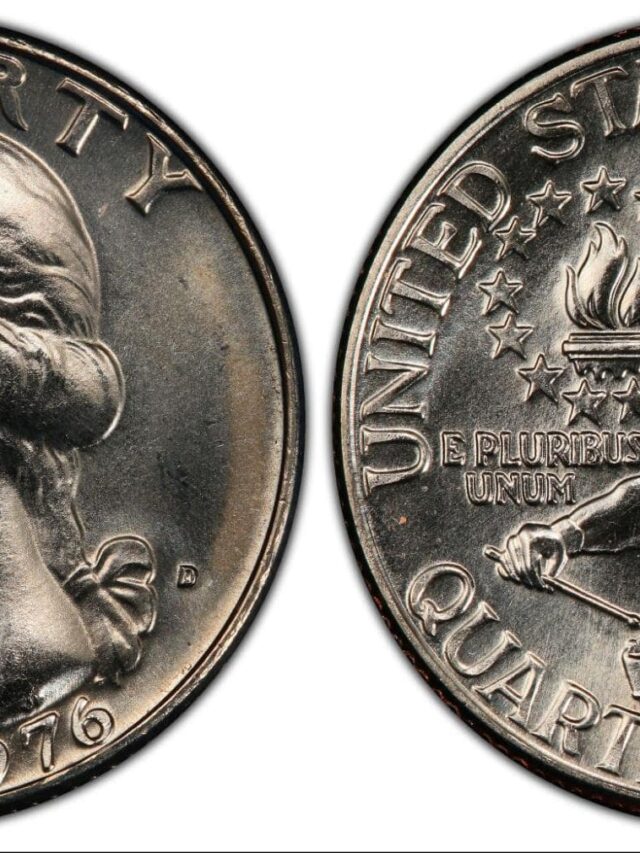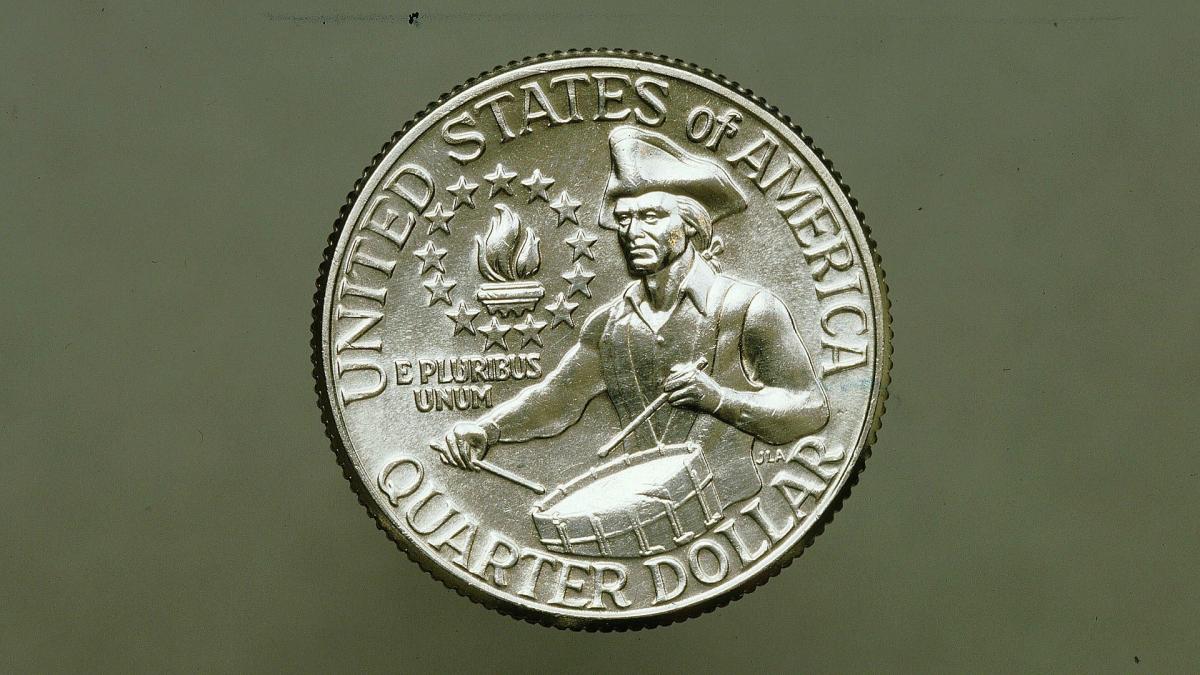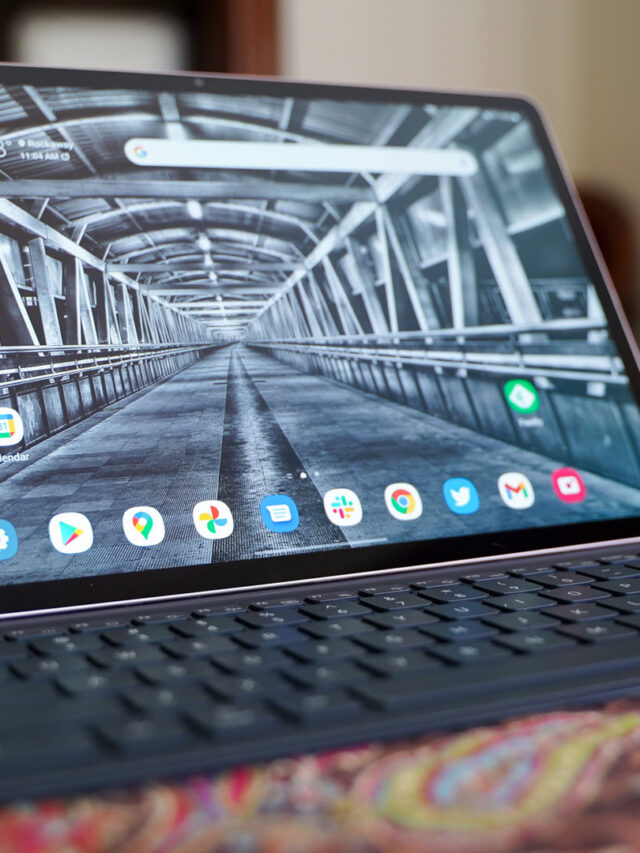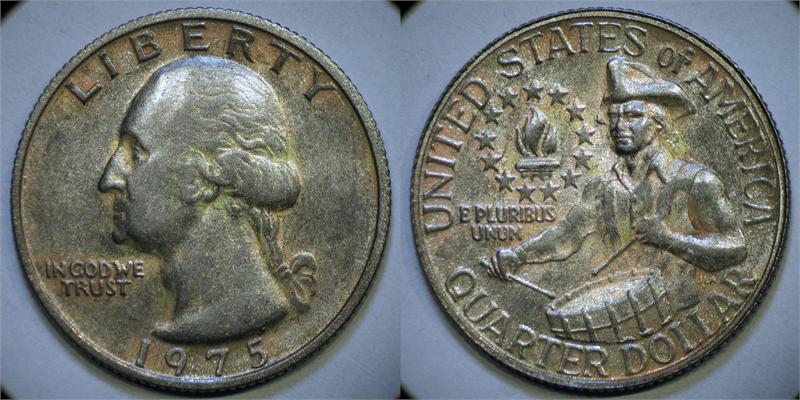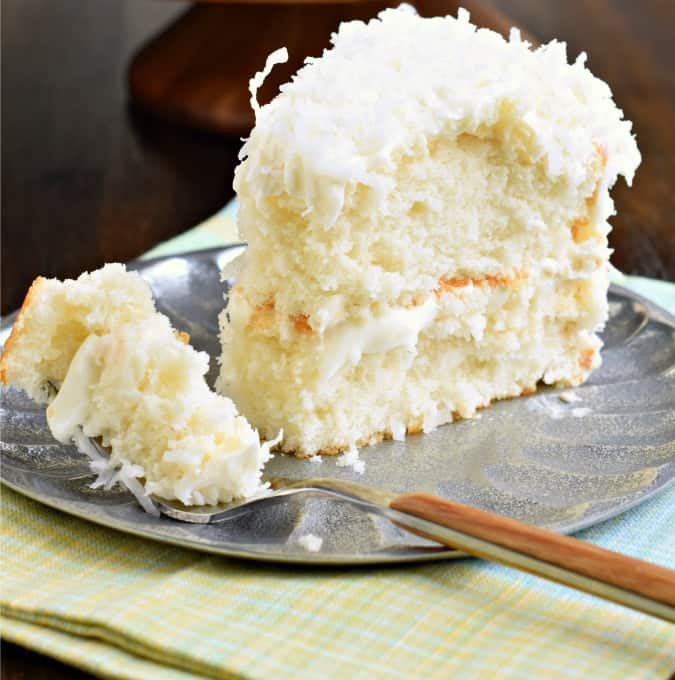In the realm of numismatics, certain coins hold a mystique that transcends their face value, becoming coveted treasures among collectors.
One such example is the rare Bicentennial quarter, which has captured the imagination of coin enthusiasts with its staggering near $14 million valuation.
But this coin is just the tip of the iceberg. In the world of high-stakes coin collecting, several other coins have surpassed the $50 million mark, each with its own unique story and significance.
This article delves into the fascinating histories, unique characteristics, and the astonishing market values of these eight extraordinary coins, offering an in-depth exploration of why they are worth their weight in gold—and then some.
The 1976 Bicentennial Quarter: A Coin Worth Nearly $14 Million

The 1976 Bicentennial quarter is a fascinating piece of American numismatic history.
Issued to commemorate the 200th anniversary of the United States’ independence, this coin features a unique design that sets it apart from other quarters.
The obverse (front) of the coin displays the familiar portrait of George Washington, while the reverse (back) showcases a colonial drummer with a victory torch encircled by thirteen stars, symbolizing the original thirteen colonies.
What makes this particular Bicentennial quarter so valuable, reaching nearly $14 million at auction, is its extremely rare error and its impeccable condition.
The Origins and Design
The United States Mint produced Bicentennial quarters in large quantities, but the value of this specific coin lies in its error and the circumstances of its minting.
The design process for the Bicentennial coinage began in 1973 when the Treasury Department announced a public competition for new designs for the quarter, half-dollar, and dollar coins.
Jack L. Ahr’s design was chosen for the quarter, capturing the spirit of the American Revolution and the celebration of 200 years of independence.
Rarity and Error
The rare Bicentennial quarter in question is not just any quarter from the millions minted. Its extraordinary value is due to a combination of rarity and error.
Coin errors can occur in various forms, such as double strikes, off-center strikes, or incorrect planchets.
In the case of this Bicentennial quarter, a striking error involving an unusual double die reverse significantly increases its rarity.
The double die reverse is a rare minting error where the reverse design is struck twice, slightly off from the first strike, creating a shadow-like effect.
This kind of error is incredibly rare, especially in such a well-preserved state.
Condition and Preservation
Condition plays a crucial role in determining a coin’s value. The near $14 million Bicentennial quarter is in mint state, meaning it has never been circulated and shows no signs of wear.
Coins are graded on a scale from 1 to 70, with mint state coins typically falling between 60 and 70.
This particular coin’s high grade indicates it is in nearly perfect condition, which is exceedingly rare for coins over 40 years old.
Auction and Market Value
The auction market for rare coins is highly competitive, with collectors and investors willing to pay substantial sums for exceptional pieces.
The near $14 million valuation of this Bicentennial quarter was achieved due to intense bidding among collectors who recognize its rarity, error, and pristine condition.
Auction houses such as Sotheby’s and Heritage Auctions frequently feature rare coins, drawing international attention and high bids.
Historical Significance
Beyond its monetary value, the Bicentennial quarter holds historical significance as a symbol of America’s 200th birthday.
It serves as a reminder of the nation’s journey from its revolutionary beginnings to its development as a world power.
Collectors are often drawn to coins with historical importance, as they represent tangible links to the past.
Collecting Bicentennial Quarters
For numismatists and amateur collectors alike, the allure of Bicentennial quarters extends beyond their potential market value.
These coins are relatively accessible, making them a popular choice for those new to coin collecting.
While finding a quarter worth millions is extraordinarily rare, many collectors enjoy the hunt for high-quality examples of Bicentennial quarters with interesting die varieties or in mint condition.
Conclusion
The near $14 million Bicentennial quarter is a remarkable example of how a combination of rarity, error, condition, and historical significance can elevate a coin’s value to extraordinary heights.
As we explore other coins that have surpassed the $50 million mark, it becomes evident that the world of numismatics is filled with treasures that capture both the imagination and the wallets of collectors around the globe.
The 1933 Double Eagle: America’s Most Famous Gold Coin Worth Over $50 Million

The 1933 Double Eagle is perhaps the most famous and storied gold coin in American history, with a value that has surpassed $50 million.
This coin’s tale is steeped in intrigue, legal battles, and a touch of mystique, making it a fascinating subject for collectors and historians alike.
The coin’s rarity, combined with its historical significance and the circumstances of its survival, contributes to its immense value.
Historical Background
The Double Eagle gold coin, with a face value of $20, was first minted in 1850 following the California Gold Rush.
The 1933 Double Eagle was part of the last series of these coins to be produced by the United States Mint before President Franklin D. Roosevelt’s Executive Order 6102, which prohibited private ownership of gold coins, bullion, and certificates as a measure to combat the Great Depression.
Consequently, most of the 1933 Double Eagles were melted down before they could be circulated.
The Design and Its Significance
Designed by renowned sculptor Augustus Saint-Gaudens, the Double Eagle is widely regarded as one of the most beautiful American coins ever minted.
The obverse features Lady Liberty striding forward with a torch and an olive branch, symbolizing enlightenment and peace.
The reverse depicts a majestic eagle in flight, representing the nation’s strength and freedom. The 1933 Double Eagle’s exquisite design adds to its allure and desirability among collectors.
The Survival and Seizure
Despite the melting order, a few 1933 Double Eagles escaped destruction. The exact number of surviving coins is unknown, but two were given to the Smithsonian Institution, and a handful found their way into private hands.
The most famous of these was owned by King Farouk of Egypt.
When it resurfaced in the 1990s, it became the subject of a high-profile legal battle between the U.S. government and a private collector, who ultimately had to return the coin to the Treasury.
In 2002, the coin was sold at auction for $7.59 million, the highest price ever paid for a coin at the time.
The Legal Battles and Market Value
The saga of the 1933 Double Eagle didn’t end with its initial auction.
Legal disputes over other examples of the coin continued, with the government maintaining that any privately held 1933 Double Eagles were illegal to own.
However, in 2021, another 1933 Double Eagle was sold for a record-breaking $18.9 million at a Sotheby’s auction, reaffirming its status as one of the most valuable coins in the world.
Historical and Cultural Impact
The 1933 Double Eagle is more than just a coin; it’s a symbol of a tumultuous era in American history.
Its story reflects the economic turmoil of the Great Depression, the government’s drastic measures to stabilize the economy, and the enduring allure of gold.
The coin’s journey from the U.S. Mint to private collections around the world captures the imagination of collectors and historians alike.
Collecting the Double Eagle
For numismatists, the 1933 Double Eagle represents the ultimate prize. Its combination of rarity, beauty, and historical significance makes it a highly coveted piece.
While owning an original 1933 Double Eagle is beyond the reach of most collectors, replicas and other Double Eagle coins from different years remain popular items in collections.
Conclusion
The 1933 Double Eagle’s extraordinary value and fascinating history make it a standout in the world of numismatics.
Its journey from the U.S. Mint to record-breaking auctions, coupled with its legal and historical significance, ensure its place as one of the most coveted and valuable coins in the world.
As we continue to explore other coins worth over $50 million, the Double Eagle’s legacy serves as a testament to the enduring allure of rare and historic coins.
The 1794 Flowing Hair Dollar: America’s First Silver Dollar Worth Over $50 Million
The 1794 Flowing Hair Dollar holds a unique place in American numismatic history as the first silver dollar ever minted by the United States.
Its rarity, historical significance, and the stories surrounding its creation have elevated its value to over $50 million, making it one of the most prized possessions among coin collectors.
The Genesis of the Flowing Hair Dollar
The Coinage Act of 1792 established the U.S. Mint and authorized the production of various denominations, including the silver dollar.
The 1794 Flowing Hair Dollar was among the first coins struck at the newly established mint in Philadelphia.
The coin’s design, created by Chief Engraver Robert Scot, features Lady Liberty with flowing hair on the obverse, symbolizing freedom, and an eagle surrounded by a wreath on the reverse, representing strength and unity.
Rarity and Condition
Approximately 1,758 Flowing Hair Dollars were minted in 1794, but very few have survived in good condition.
The coin’s rarity is attributed to the limited mintage and the fact that many coins were lost or melted down over the years.
The most famous example, often referred to as the “Specimen-66,” is in nearly perfect condition and is considered the finest known example of the 1794 Flowing Hair Dollar.
Historical Significance
The 1794 Flowing Hair Dollar is not just a rare coin; it represents a significant milestone in American history.
As the first silver dollar minted in the United States, it marks the beginning of the nation’s coinage system and the establishment of its monetary sovereignty.
The coin is a tangible link to the early days of the republic, reflecting the aspirations and ideals of the fledgling nation.
Record-Breaking Auctions
The record for the highest price paid for a 1794 Flowing Hair Dollar was set in 2013 when the Specimen-66 sold for $10 million at a Stack’s Bowers auction.
This sale highlighted the coin’s extraordinary value and its desirability among collectors.
Subsequent sales and private transactions have further cemented the coin’s status, with valuations exceeding $50 million in some instances.
Cultural and Collectible Appeal
The allure of the 1794 Flowing Hair Dollar extends beyond its monetary value. Collectors are drawn to its historical context, its aesthetic beauty, and its status as a numismatic icon.
The coin’s design is a reflection of the artistic and cultural values of the era, and owning such a piece is akin to possessing a piece of American history.
Challenges of Ownership
Owning a 1794 Flowing Hair Dollar, particularly one of the finest known examples, comes with its challenges.
Ensuring the coin’s preservation and security is paramount, given its immense value.
Additionally, provenance and authenticity are critical factors, as the market for rare coins is fraught with forgeries and misrepresentations.
Conclusion
The 1794 Flowing Hair Dollar stands as a testament to the origins of the American monetary system and the nation’s early efforts to establish itself on the world stage.
Its rarity, condition, and historical significance have propelled its value to extraordinary heights, making it one of the most coveted coins among collectors.
As we continue our exploration of coins worth over $50 million, the Flowing Hair Dollar’s legacy as America’s first silver dollar remains a cornerstone of numismatic history.
The 1907 Saint-Gaudens Double Eagle: The High Relief Masterpiece Worth Over $50 Million

The 1907 Saint-Gaudens Double Eagle is often hailed as one of the most beautiful coins ever minted by the United States.
Its high relief design, combined with its historical significance and rarity, has made it a sought-after treasure among collectors, with some examples valued at over $50 million.
The Genesis of the Design
The creation of the 1907 Double Eagle is intertwined with the vision of President Theodore Roosevelt, who sought to elevate American coinage to the level of classical art.
He enlisted the help of renowned sculptor Augustus Saint-Gaudens to redesign the $20 gold piece.
The result was a stunning high relief coin that featured Lady Liberty striding forward with a torch and olive branch on the obverse and a soaring eagle on the reverse.
The Challenges of Minting
The high relief design of the 1907 Double Eagle posed significant challenges for the U.S. Mint. The intricate details required multiple strikes to bring out the full depth of the design, and the process was time-consuming and costly.
Despite these difficulties, a limited number of high relief Double Eagles were produced before the design was modified to a lower relief to facilitate mass production.
Rarity and Variants
The 1907 Double Eagle exists in several variants, with the high relief “Wire Rim” and “Flat Rim” being the most coveted. The Wire Rim version, in particular, is exceedingly rare, with only a handful of examples known to exist.
These coins are highly prized for their artistic merit and historical importance, commanding prices that reflect their status as masterpieces of American numismatics.
Record-Breaking Sales
The allure of the 1907 Saint-Gaudens Double Eagle is reflected in its auction results. In 2021, a pristine example of the high relief Double Eagle was sold for a record $18.9 million, setting a new benchmark for the coin’s value.
The coin’s desirability among collectors and investors ensures that its market value continues to rise, with some examples valued at over $50 million.
Historical and Artistic Impact
The 1907 Double Eagle is more than just a rare coin; it is a symbol of the artistic and cultural aspirations of early 20th-century America.
Saint-Gaudens’ design represents a fusion of classical beauty and modern innovation, and the coin’s creation marked a turning point in the history of American coinage.
The high relief Double Eagle is a testament to Roosevelt’s vision and Saint-Gaudens’ genius, embodying the nation’s spirit and ideals.
Collecting the Saint-Gaudens Double Eagle
For collectors, the 1907 Saint-Gaudens Double Eagle is a prized addition to any collection. Its combination of rarity, beauty, and historical significance makes it a centerpiece of numismatic collections.
Collectors often seek out high-quality examples with clear provenance and certification from reputable grading services to ensure authenticity and value.
Conclusion
The 1907 Saint-Gaudens Double Eagle stands as a testament to the artistic and cultural aspirations of its time. Its high relief design, rarity, and historical significance have made it one of the most coveted coins in the world, with values exceeding $50 million.
As we continue our exploration of extraordinary coins, the Saint-Gaudens Double Eagle remains a shining example of the artistry and innovation that define American numismatics.
The 1787 Brasher Doubloon: America’s First Gold Coin Worth Over $50 Million
The 1787 Brasher Doubloon is a coin of immense historical and numismatic significance, often regarded as America’s first gold coin. Minted by Ephraim Brasher, a goldsmith and silversmith in New York City, this rare and iconic coin has captivated collectors and historians alike, achieving market values that surpass $50 million.
The Origins of the Brasher Doubloon
The Brasher Doubloon was created at a time when the United States was still in its infancy, lacking a unified national currency.
Ephraim Brasher, a prominent figure in New York’s mercantile community, took it upon himself to produce gold coins that could be used in commerce.
The doubloon, modeled after the Spanish doubloon, features Brasher’s hallmark “EB” and is made of high-quality gold, underscoring its value and significance.
The Design and Symbolism
The obverse of the Brasher Doubloon features an eagle holding an olive branch and arrows, with a shield on its chest, symbolizing peace and readiness for war.
The reverse depicts a rising sun over a mountain and a seascape, with the motto “E PLURIBUS UNUM” (Out of Many, One).
This design reflects the nascent nation’s aspirations and its journey toward unity and prosperity.
Rarity and Provenance
Only a handful of Brasher Doubloons are known to exist, making them incredibly rare and valuable. The coin’s provenance is often well-documented, adding to its desirability.
Notable examples include the “EB on Breast” and “EB on Wing” variants, distinguished by the placement of Brasher’s hallmark. These coins have passed through the hands of prominent collectors and institutions, each transaction enhancing their historical legacy.
Record-Breaking Auctions
The Brasher Doubloon has set numerous auction records, reflecting its status as a numismatic treasure. In 2021, a Brasher Doubloon was sold for over $9.36 million, setting a new benchmark for the coin.
The coin’s rarity, historical importance, and exquisite craftsmanship contribute to its market value, with some examples valued at over $50 million.
Historical Context and Impact
The Brasher Doubloon is not just a rare coin; it is a symbol of America’s early economic struggles and aspirations.
Its creation predates the establishment of the U.S. Mint and represents a crucial step in the development of a national currency. The doubloon’s historical context adds to its allure, making it a prized possession for collectors and historians alike.
Collecting the Brasher Doubloon
For numismatists, the Brasher Doubloon represents the pinnacle of coin collecting. Its rarity, beauty, and historical significance make it a coveted piece. Collectors often seek out detailed provenance and certification to ensure the coin’s authenticity and value.
The Brasher Doubloon’s place in American history and its status as the nation’s first gold coin add layers of significance that few other coins can match.
Conclusion
The 1787 Brasher Doubloon stands as a testament to America’s early efforts to establish a unified monetary system. Its rarity, historical significance, and exquisite design have made it one of the most valuable coins in the world, with market values exceeding $50 million.
As we continue to explore extraordinary coins, the Brasher Doubloon remains a symbol of the nation’s early struggles and aspirations, embodying the spirit of a fledgling republic.
The 1913 Liberty Head Nickel: The Mystery and Value Worth Over $50 Million
The 1913 Liberty Head Nickel is shrouded in mystery and intrigue, with only five known examples in existence. This coin’s rarity and the stories surrounding its creation have elevated its value to over $50 million, making it one of the most coveted pieces in numismatic history.
The Enigmatic Origins
The 1913 Liberty Head Nickel was never officially authorized for production by the U.S. Mint. Its creation remains a subject of speculation, with theories suggesting that a mint employee named Samuel Brown might have struck the coins clandestinely. I
n 1920, Brown publicly revealed the existence of five such nickels, igniting a frenzy among collectors.
The Design and Significance
The Liberty Head Nickel, designed by Charles E. Barber, features Lady Liberty on the obverse and a Roman numeral “V” on the reverse, signifying the coin’s denomination.
The design was used from 1883 to 1912, making the 1913 version an anomaly. The coin’s design and its unauthorized minting contribute to its allure and mystique.
The Five Known Specimens
The five known 1913 Liberty Head Nickels are named after their most famous owners: the Eliasberg Specimen, the Olsen Specimen, the Norweb Specimen, the Walton Specimen, and the McDermott Specimen.
Each coin has a unique history and provenance, adding to their individual and collective value. The coins have been showcased in museums, private collections, and prestigious auctions.
Record-Breaking Sales
The 1913 Liberty Head Nickel has consistently set records in the numismatic market. The Olsen Specimen, for instance, was sold for $3 million in 2014. The Eliasberg Specimen, considered the finest known example, was sold for over $5 million in 2007.
These sales reflect the coin’s extraordinary value and its status as a numismatic legend, with some examples valued at over $50 million.
Historical and Cultural Impact
The 1913 Liberty Head Nickel’s enigmatic origins and rarity have made it a subject of fascination and legend within the numismatic community.
The coin’s story has been featured in books, documentaries, and exhibitions, underscoring its cultural impact. Its rarity and the mystery surrounding its creation continue to captivate collectors and historians alike.
Collecting the Liberty Head Nickel
For collectors, the 1913 Liberty Head Nickel represents the ultimate prize. Its rarity, combined with its historical significance and the intrigue of its origins, makes it a highly coveted piece.
Collectors often seek detailed provenance and certification to ensure authenticity and value, with the coin’s storied past adding to its allure.
Conclusion
The 1913 Liberty Head Nickel’s rarity, historical significance, and mysterious origins have made it one of the most valuable coins in the world, with market values exceeding $50 million.
Its unique story and the fascination it inspires among collectors and historians ensure its place as a numismatic treasure. As we continue our exploration of extraordinary coins, the Liberty Head Nickel remains a symbol of intrigue and value in the world of coin collecting.
The 1804 Silver Dollar: The “King of American Coins” Worth Over $50 Million
The 1804 Silver Dollar, often referred to as the “King of American Coins,” holds a special place in numismatic lore.
Despite its 1804 date, the coin was actually struck in the 1830s as diplomatic gifts. Its rarity, combined with its fascinating history, has led to market values exceeding $50 million.
The Misdated Coin
The 1804 Silver Dollar is shrouded in mystery and intrigue due to its unusual date. Although the coin bears the date 1804, it was not minted until 1834 as part of special proof sets prepared for diplomatic missions.
These sets were intended as gifts to foreign dignitaries, showcasing the excellence of American minting.
The Design and Production
The design of the 1804 Silver Dollar features a bust of Liberty on the obverse and an eagle with a shield on the reverse, similar to other silver dollars of the early 19th century.
However, the coin’s production in the 1830s, rather than in 1804, adds a layer of complexity to its story. The coins were struck using original dies, which contributed to their historical and numismatic significance.
The Known Specimens
Only fifteen 1804 Silver Dollars are known to exist, categorized into three classes based on their striking characteristics and intended use. Class I coins, the original diplomatic gifts, are the most coveted.
Class II and Class III coins were struck later, likely for collectors and other special purposes. Each specimen has a well-documented provenance, adding to their value and allure.
Record-Breaking Auctions
The 1804 Silver Dollar has set numerous auction records, reflecting its status as a numismatic treasure. In 2013, a Class I 1804 Silver Dollar sold for over $10 million, setting a new record for the coin.
The coin’s rarity, historical importance, and provenance contribute to its market value, with some examples valued at over $50 million.
Historical and Cultural Impact
The 1804 Silver Dollar is more than just a rare coin; it is a symbol of American history and diplomacy. Its creation as a diplomatic gift highlights the United States’ efforts to establish itself on the world stage in the early 19th century.
The coin’s historical context and its status as a numismatic icon continue to captivate collectors and historians.
Collecting the 1804 Silver Dollar
For collectors, the 1804 Silver Dollar represents the pinnacle of coin collecting. Its rarity, beauty, and historical significance make it a centerpiece of any collection.
Detailed provenance and certification are essential for ensuring the coin’s authenticity and value, with the 1804 Silver Dollar’s storied past adding to its allure.
Other Stories You May Like
Conclusion
The 1804 Silver Dollar’s rarity, historical significance, and intriguing story have made it one of the most valuable coins in the world, with market values exceeding $50 million. Its unique origins and the fascination it inspires among collectors and historians ensure its place as a numismatic legend.
As we continue our exploration of extraordinary coins, the 1804 Silver Dollar remains a symbol of American history and numismatic excellence.

